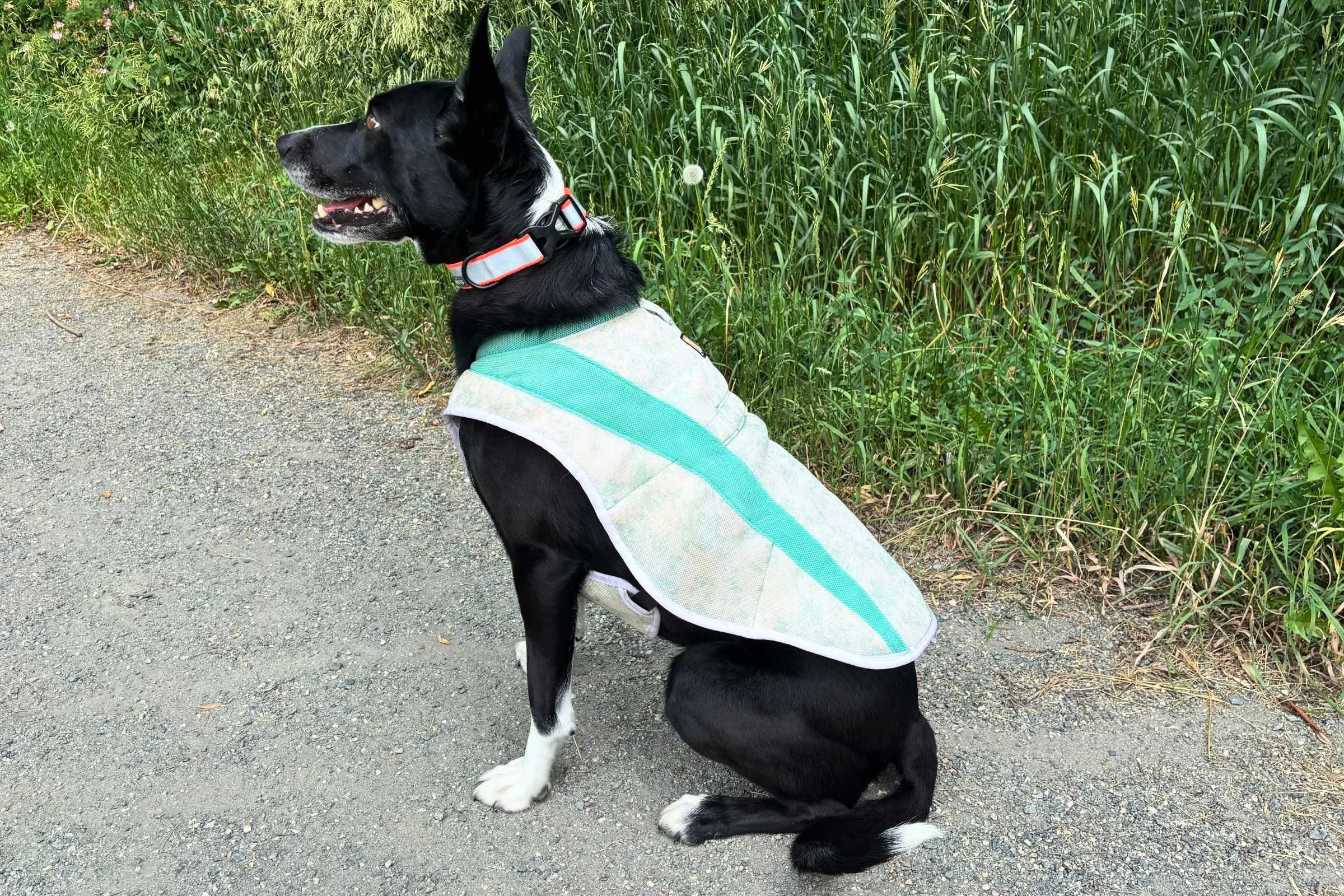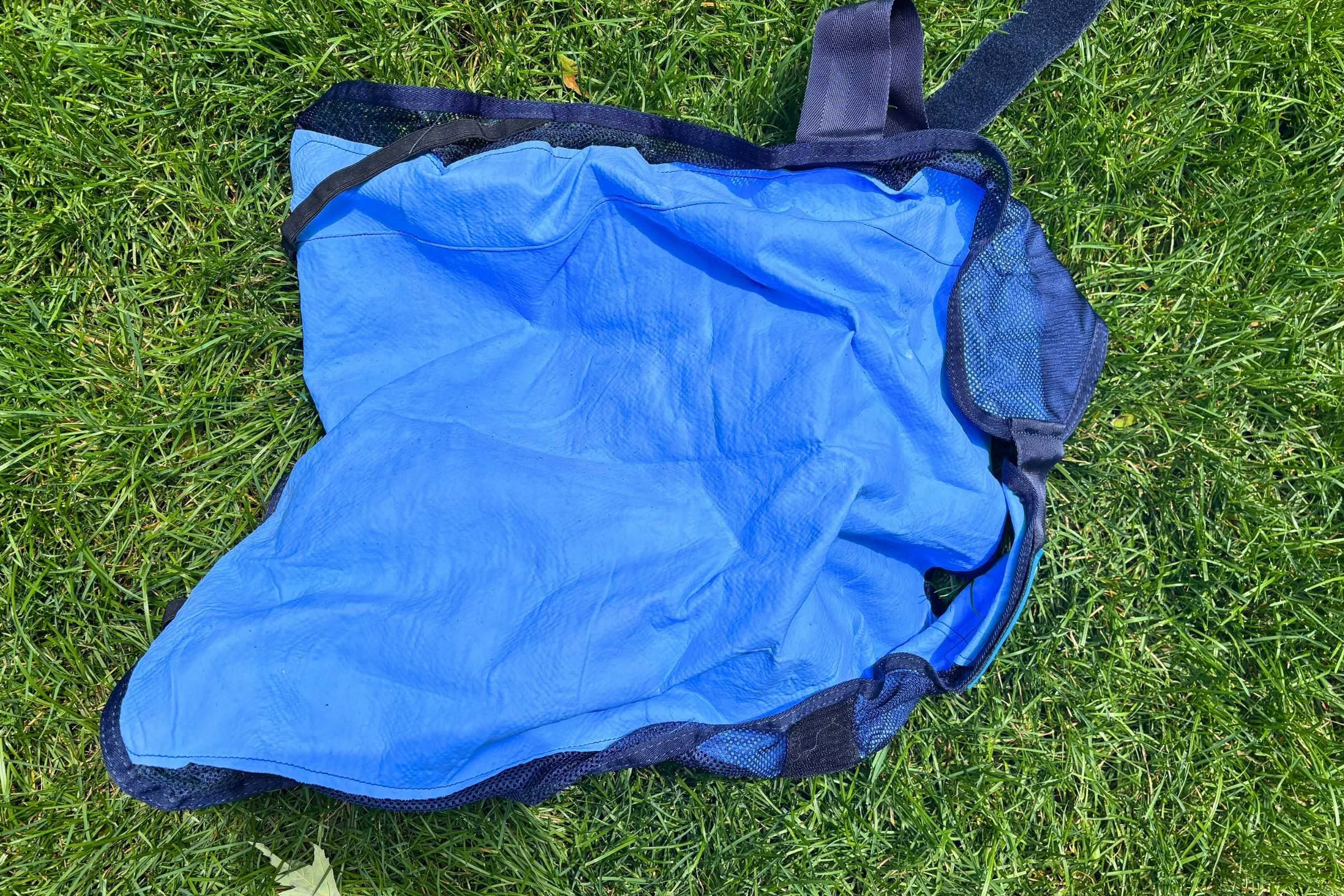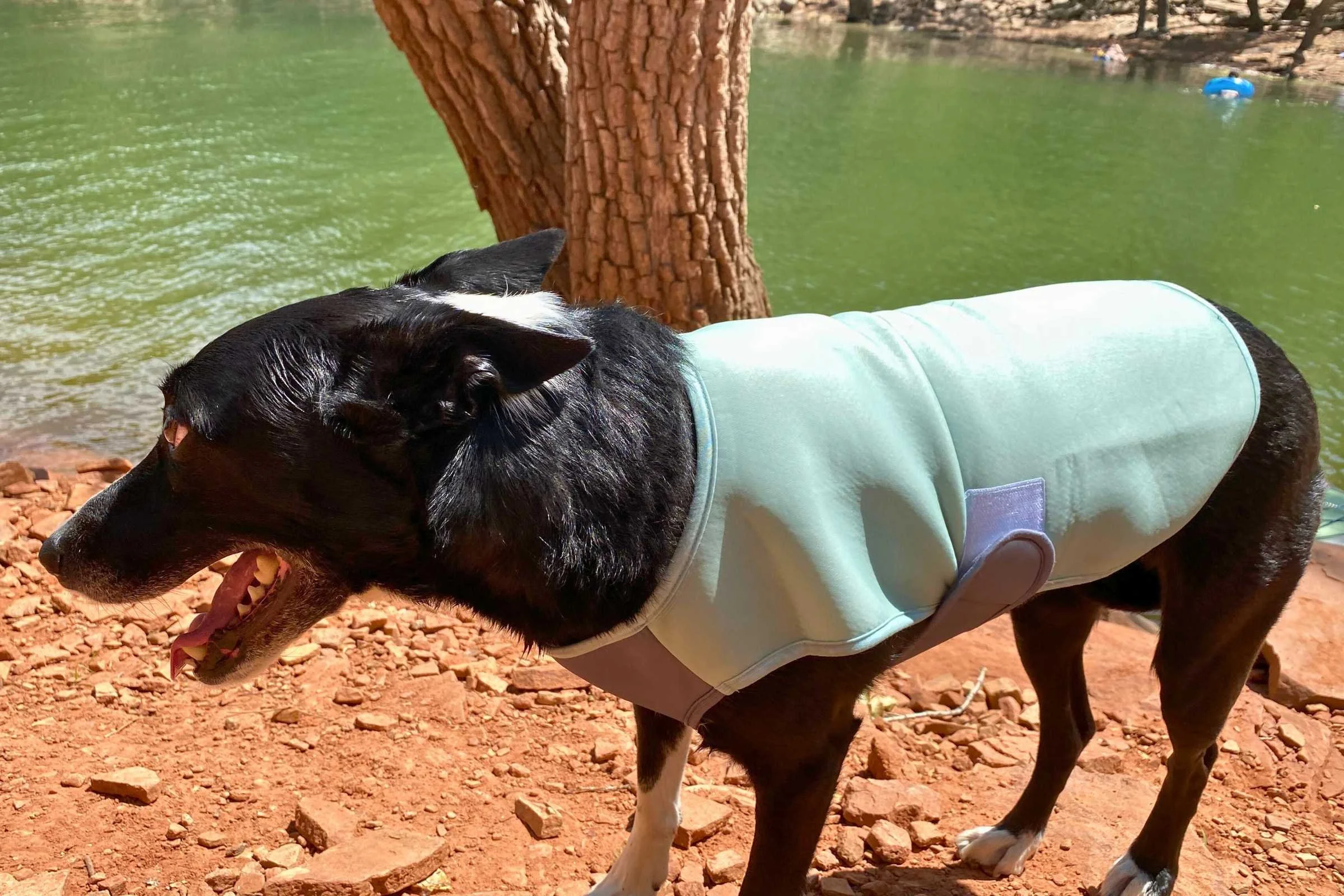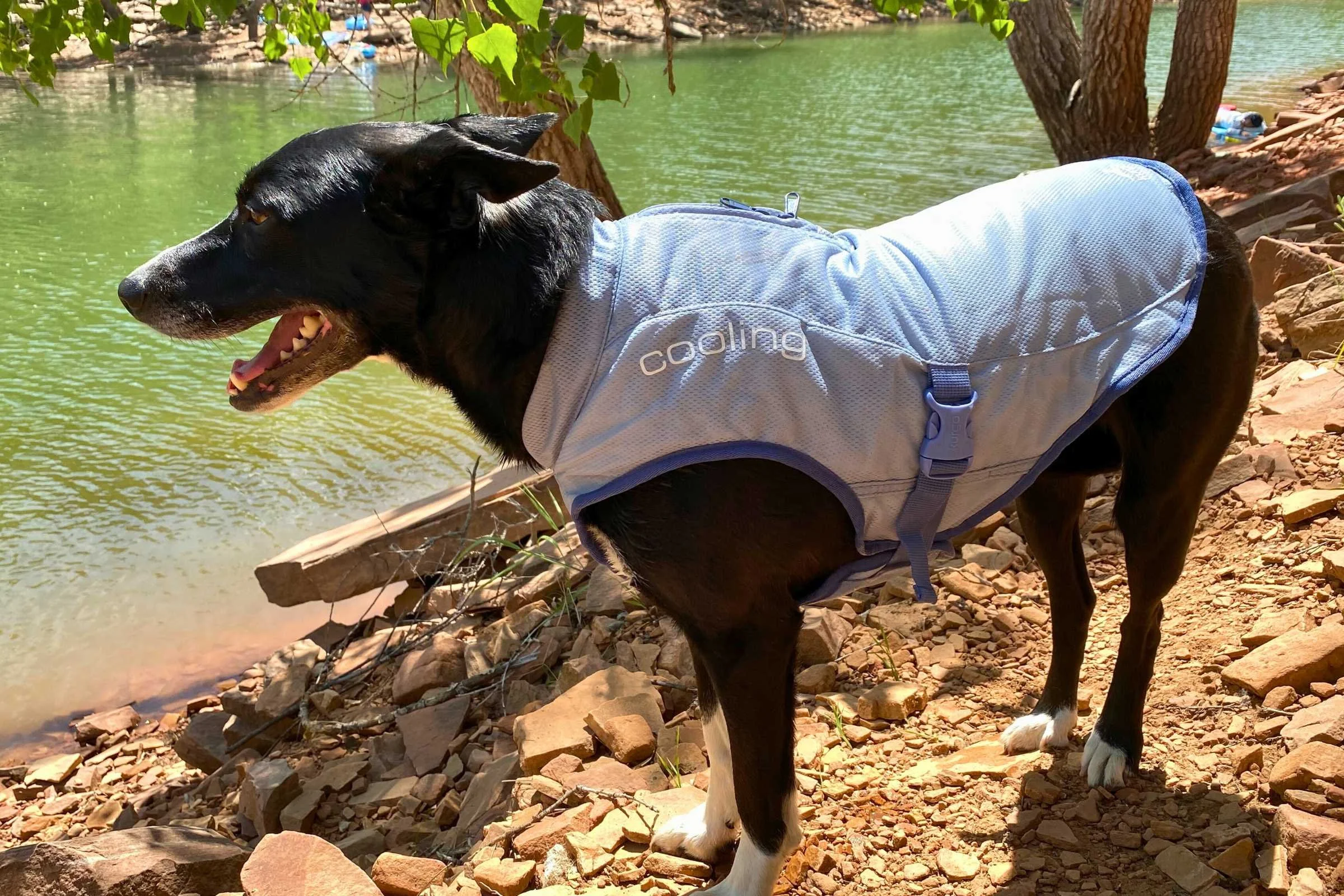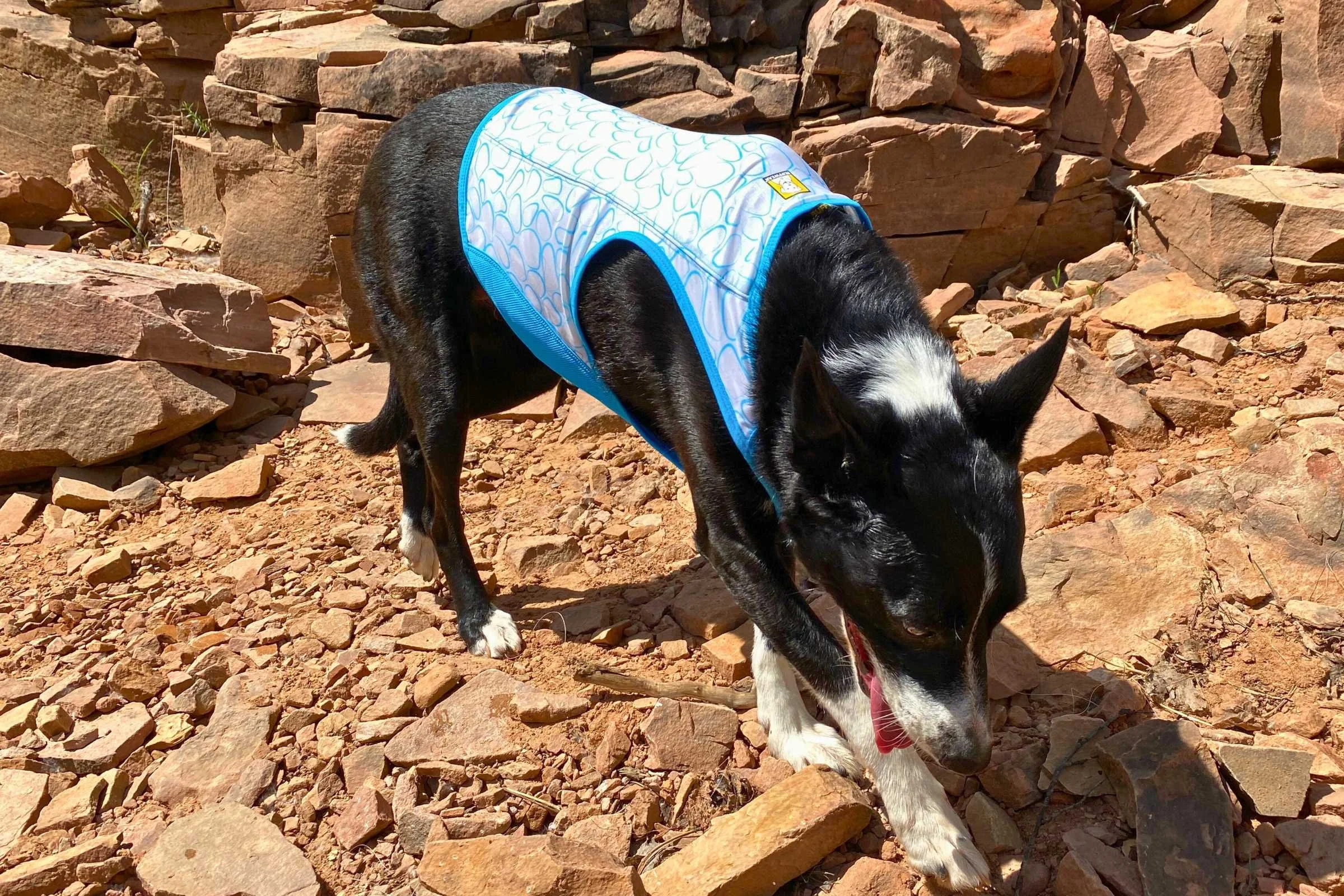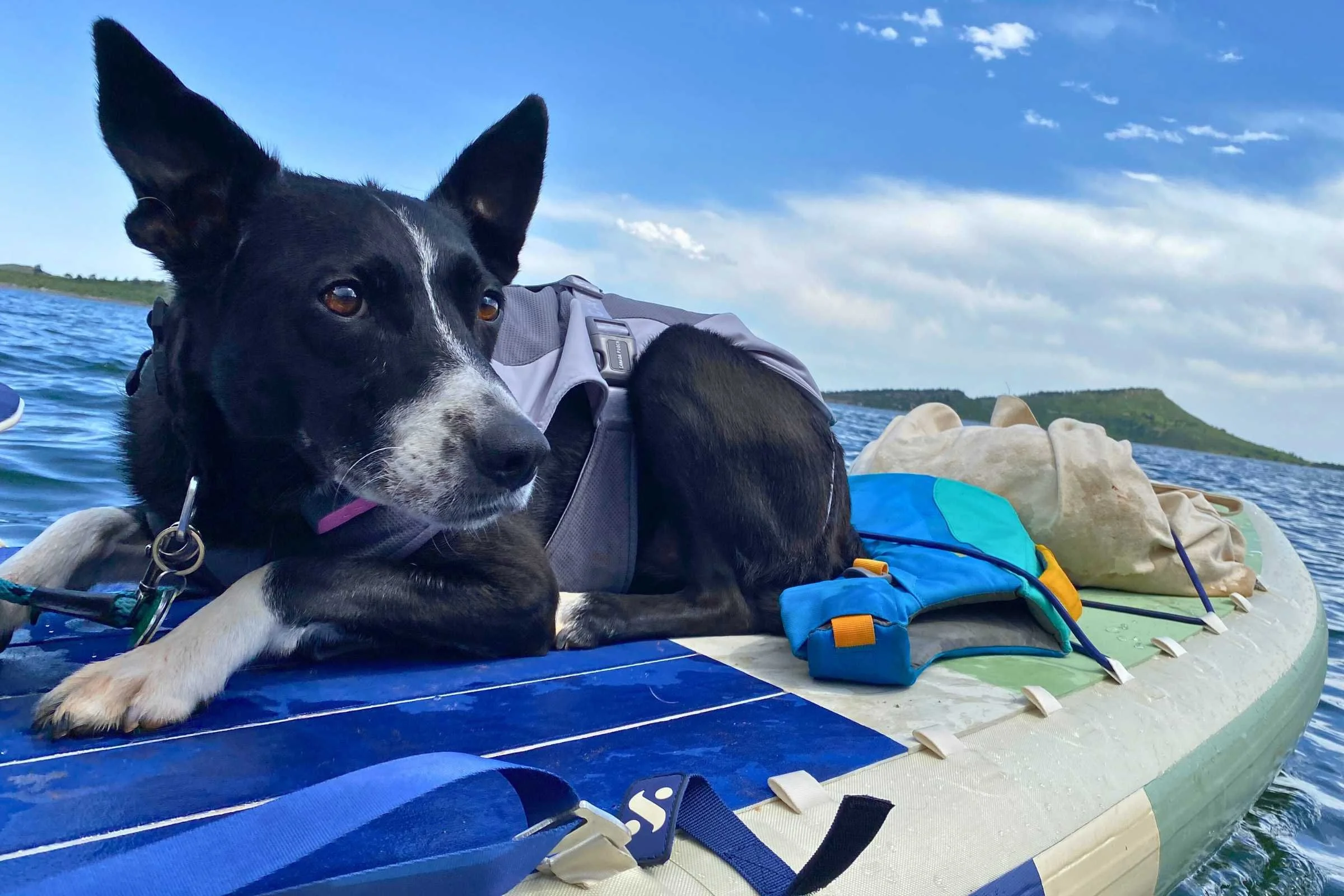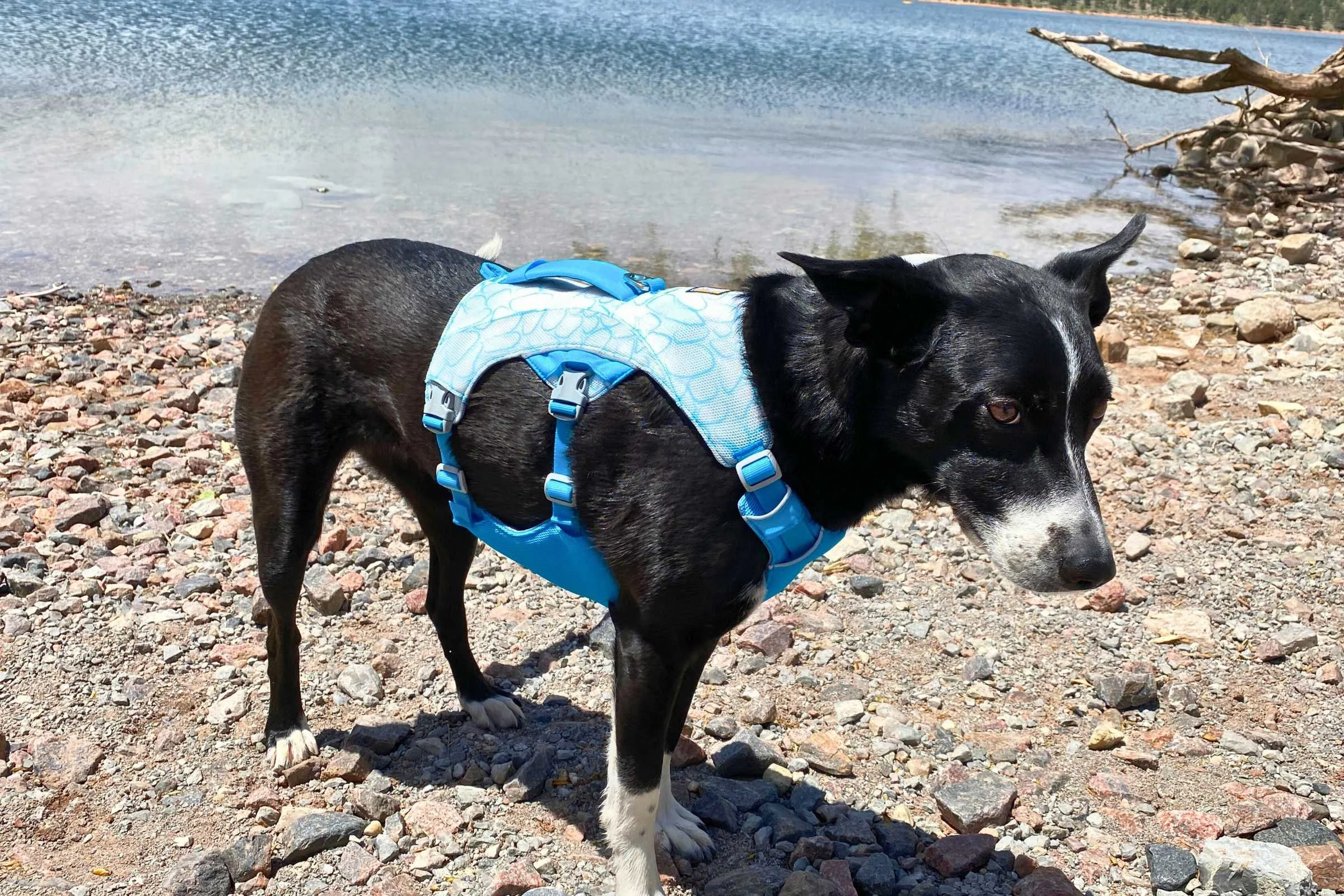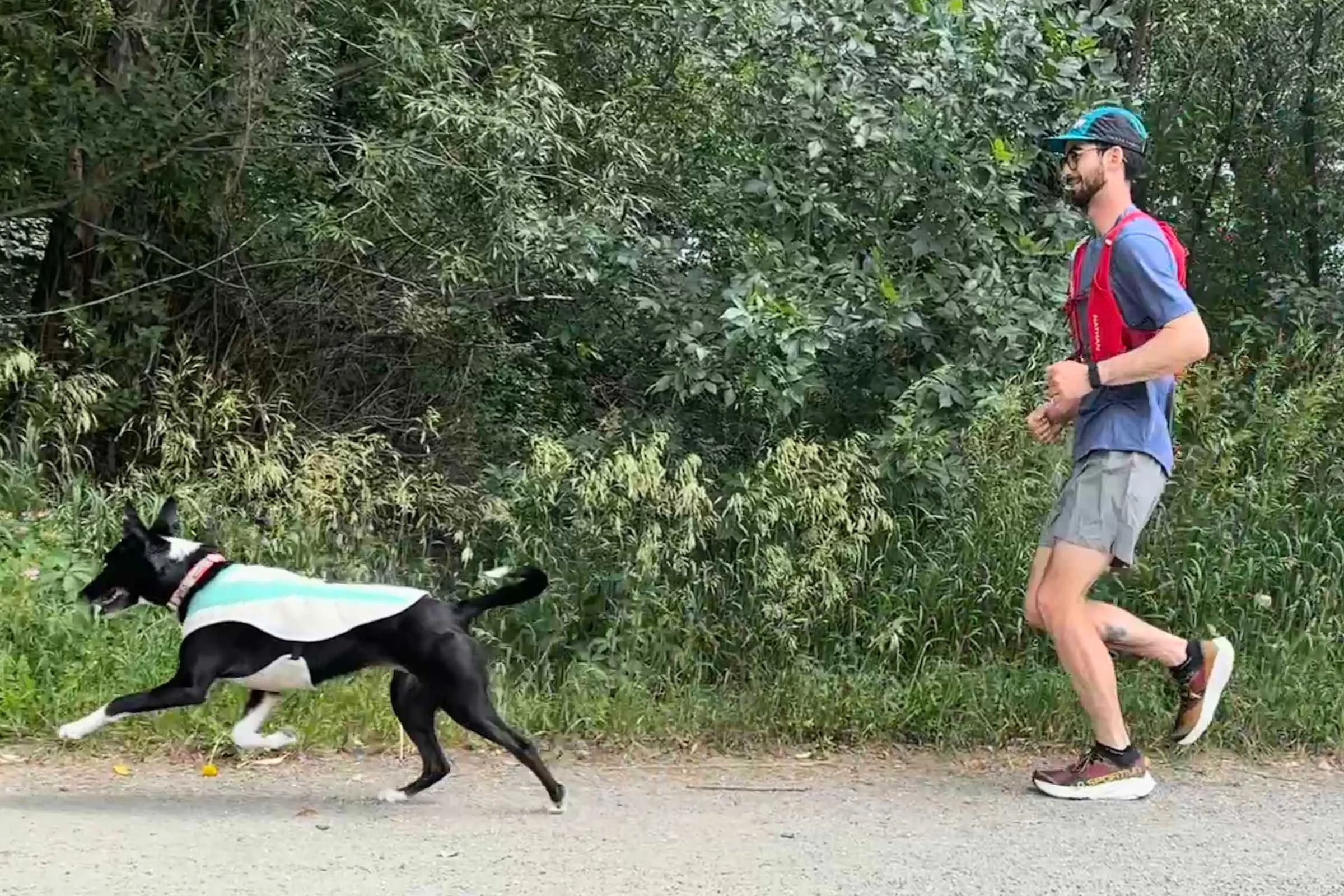Best Dog Cooling Vests of 2025
Dog cooling gear to keep your pet from getting too hot
For short coated dogs and dark-colored dogs, cooling vests offer much-needed protection from the hot sun. Photo by Jae Thomas
July 17th, 2025
Home → Gear Reviews → Dogs
Even though you may feel comfortable hiking in 80+ degree weather, your dog may not agree.
Dogs are much more heat sensitive than humans, and they dissipate heat through panting and through their paws, instead of through sweating like we do. Dogs cool themselves much less efficiently than humans, which means that your dog will likely be hotter than you are in warm weather, and will have a harder time cooling down once they’re already hot.
Dog cooling gear, like dog cooling vests, can be incredibly helpful in extending your active season with your dog, so they don’t end up sitting on the couch all summer because it’s too hot.
In the right conditions, a dog cooling vest will keep your furry friend from overheating. You should still take precautions—like getting outside early in the morning or later in the evening and avoiding prolonged activities in high humidity—to ensure your dog is at a comfortable temperature during your outdoor adventures.
Dogs who are predisposed to heat sensitivity (like brachycephalic breeds, old dogs, and young puppies) should also take extra precaution in the heat, even if they’re wearing cooling gear.
Your dog’s coat will also play a role in their heat tolerance. Short-coated and black dogs generally are more sensitive to the heat and direct sunlight than their double-coated counterparts. As the owner of a short-coated, black dog who loves being outside but gets overheated very quickly, cooling vests have been a necessary part of my dog’s gear every summer.
I’m also a Certified Professional Dog Trainer (CPDT-KA) and I take the safety of all dogs (both my personal dogs and my client dogs) very seriously. I put 7 top dog cooling vests to the test to see which ones actually cooled my dogs down in direct sunlight, and which ones are worth a spot on your dog’s summer gear list.
This story may contain affiliate links, which help fund our website. When you click on the links to purchase gear, we may get a commission without costing you an extra cent. This allows us to create reader-supported, objective gear reviews. Thank you for supporting our work and mission of outdoor coverage for every body! Learn more.
Comparison table
| DOG COOLING VEST | TREELINE AWARD | MSRP* | COOLING METHOD | WEIGHT | SIZES AVAILABLE |
|---|---|---|---|---|---|
| Ruffwear Swamp Cooler Cooling Dog Vest | Best Overall Read why |
$70 | Evaporative cooling | 8.75 oz (size S) | XSmall - XLarge |
| Back on Track Cool on Track Cooling Dog Coat | Best Affordable Read why |
$30 | Evaporative cooling | 7.02 oz (size 60cm) | 25cm-80cm |
| Ruffwear Swamp Cooler Dog Cooling Harness | Best for Active and Working Dogs Read why |
$80 | Evaporative cooling | 8.47 oz (size S) | XXsmall - Large/XLarge |
| Canada Pooch Cooling 2.0 Dog Vest | $48 | Evaporative Cooling | 7.2 oz (S) | Back length: 8" to 32" Chest girth: 13" to 52" | |
| Frisco Summer UPF 45 Cooling Dog Vest | $19 | Evaporative Cooling | 6.4 oz (S) | XS-XXL |
The winners
Best overall dog cooling vest: Ruffwear Swamp Cooler Cooling Dog Vest
Cooling method: Evaporative cooling
Weight: 8.75 oz (size S)
Sizes available: XSmall - XLarge
What we liked: Best cooling performance; easy on and off design; big range of sizes; high coverage
What we didn’t like: A bit bulky
The Ruffwear Swamp Cooler Cooling Dog Vest performed the best by far in our lab-style temperature test, bringing my dog’s surface temperature down over 80 degrees in just three minutes of wear, from 172 degrees to 91.5 degrees. Note that the tester dog I used for this test is black, and her surface temperature went up quite a lot after 3 minutes in direct sunlight on a 90 degree day (black and dark colored dogs really do get hotter in the sun than lighter dogs). The difference was not as stark when I ran this test using a lighter colored dog.
It also sat in the middle of the pack in the drying test, meaning that it holds onto moisture long enough to cool your dog down, but doesn’t take forever to fully dry.
The three-layer construction is the most technical of the cooling vests on this list. The vest features a tight woven, UPF 50+ rated outer layer that reflects heat, protects your dog from the sun, and encourages evaporation. The middle layer soaks up water, and the inner mesh layer keeps your dog cool and dry.
Ruffwear Swamp Cooler Cooling Dog Vest
The Swamp Cooler vest felt a bit heavy, but cooled my tester dog down the best.
It also sat in the middle of the pack in the drying test, meaning that it holds onto moisture long
This vest was one of the easiest options to put on, and only requires slipping your dog’s head through, then fastening two side buckles. It has a good amount of coverage, and when sized well covers from the base of your dog’s neck all the way down their back.
This vest doesn’t have hind leg loops, which is good for dogs who don’t like them, but means that it might shift around a bit if your dog is running or playing hard. When wet, this vest also feels a bit heavy, but the weight of the water in it does a good job at keeping the back part of the vest weighted down.
Best affordable dog cooling vest: Back on Track Cool on Track Cooling Dog Coat
Cooling method: Evaporative cooling
Weight: 7.02 oz (size 60cm)
Sizes available: 25cm-80cm
What we liked: Velcro design is easy on/off; good cooling performance, lightweight
What we didn’t like: Needed to be wrung out more than other options; took a long time to fully dry; materials aren’t the most durable; stiff when dry; has complicated storage instructions
The Cool on Track Cooling Dog Coat was the second best in our temperature testing, bringing my dog’s surface temperature down by over 70 degrees. This vest is easy to put on and take off, and is good for head-shy dogs, since you don’t have to pull it over their heads (the coat secures around the dog’s chest and around their belly with Velcro straps).
The internal material on this vest feels like a shammy and was way more absorbent than other options we tested. It needed to be squeezed out more than other options on this list before use and it took the longest to dry. High absorbency in a dog cooling vest is a double-edged sword—they’ll last longer, but if the conditions aren’t appropriate, they may not actually cool your dog through evaporation, instead just making them hot and wet.
Back on Track Cool on Track Cooling Dog Coat
Though this coat works well, the materials are a bit finicky and have some complicated instructions. Because the inner layer gets stiff when it’s completely dry (and can be easily damaged when dry), it’s recommended for users to store it damp in its original zippered plastic bag. The washing instructions say hand wash only, but they also say that if the coat develops mold from being damp, that it can be washed in soap and water.
I’d prefer to let the coat dry completely before storing it and just be careful about not manipulating the fabric while it’s dry instead of having to worry about potential mold issues.
This coat has a variable price based on sizing, but the difference in cost between the smaller and larger sizes was much less than the Canada Pooch Vest. The Cool on Track coat runs $30 for the smallest size and $45 for the largest.
Best vest for active and working dogs: Ruffwear Swamp Cooler Dog Cooling Harness
Cooling method: Evaporative cooling
Weight: 8.47 oz (size S)
Sizes available: XXsmall - Large/XLarge
What we liked: Doesn’t require a separate harness; similar cooling performance as our top pick
What we didn’t like: Lower coverage than other options; some user reviews mention dogs being in-between sizes
If you have a dog who hikes, camps, or works regularly, the Ruffwear Swamp Cooler Dog Cooling Harness is a good option since it doubles as a harness. A big mistake many people make with dog cooling vests is buying one that has a harness hole on it so that their dog can wear a harness underneath the vest.
However, evaporative cooling vests need to be in contact with your dog’s skin in order to work. So, if your pup has a harness on under their cooling vest, a large part of their core won’t be touching the vest, and they’ll essentially have two layers on, potentially making it easier for them to overheat.
A harness that doubles as a cooling vest is the best way to avoid this problem, especially for dogs who need to wear harnesses (brachy breeds, puppies, service dogs, etc). The design of this harness is similar to Ruffwear’s Webmaster harness, with good front and back coverage, though it covers less of your dog’s back than the other top two cooling vests on this list.
Ruffwear Swamp Cooler Dog Cooling Harness
The handle on this harness is helpful for assisting dogs up rocks or other difficult features on hikes, and the thick D ring is easy to attach a leash to. This harness is also relatively easy to get on and off, as you just need to slip it over your dog’s head and secure the two buckles.
Though the size medium in this harness worked well for my medium sized 40–45 pound dogs, some user reviews mentioned that their dogs sat right between the medium and large size, with the medium riding into their dog’s armpits, but the large being too big to cool properly. Measure your dog accurately before ordering this harness, and if your pup is between sizes, consider one of the other cooling vest options on this list.
Other cooling vests we tested
Canada Pooch Cooling 2.0 Dog Vest
Cooling method: Evaporative Cooling
Weight: 7.2 oz (S)
Sizes available: Back length: 8" to 32"
Chest girth: 13" to 52"
The Canada Pooch Cooling 2.0 vest performed similarly to our budget pick, doing a good job of cooling my tester dogs down in direct sunlight. The material is lightweight and actually feels cool to the touch when wet, and I liked that the gray color didn’t get as dirty as the other lighter colored options on this list.
Canada Pooch Cooling 2.0 Dog Vest
The belt design made this coat the easiest to put on by far, since you just need to slip the vest over your dog’s head, then fasten one buckle around their waist. This vest also has high coverage (neck to base of tail), didn’t dry out too quickly, and comes in a variety of sizes.
However, the pricing of this vest varies based on size, with the smallest size costing $40 and the largest size costing $70. It underperformed in comparison to our $70 top pick, but would be a good budget option for folks with smaller dogs.
Cooling method: Evaporative Cooling
Weight: 6.4 oz (S)
Sizes available: XS-XXL
This Frisco cooling vest is easy to put on and is rated UPF 45 to protect your dog from the sun—especially helpful for short-coated dogs. I found the length of this vest to be too short for the recommended size based on breeds, but many user reviews from small dog owners stated that the body length was too long for their dogs. Either way, the sizing was inconsistent, the neoprene-style fabric dried much quicker than other options on this list.
Frisco Summer UPF 45 Cooling Dog Vest
The Frisco vest dried out the fastest during testing.
Cooling method: Evaporative Cooling
Weight: 7 oz (S)
Sizes available: S-XL
This Kurgo cooling vest sat in the middle of the pack in terms of cooling performance, but it was the second quickest to dry out completely. During field testing, it needed to be re-wet more often than other options to keep my tester dogs cool. The fit was adequate and the material is lightweight, but I wouldn’t choose this option over our top pick or budget pick, especially since the retail price of $64 is so close to the retail price of our top pick.
Kurgo Core Cooling Dog Vest
The Kurgo vest offers high coverage, but didn’t perform as well as our top picks.
Cooling method: Evaporative Cooling
Weight: 8.6 oz (S)
Sizes available: XXS-XL
The material of this vest felt very cool to the touch when it was wet, but it performed the worst of the pack in our lab-style cooling tests. The thicker Ruffwear Swamp Cooler is better in most respects, but the zip version is much more lightweight and packable, and has full coverage around the chest area. This version is harder to put on and take off your dog, since you need to lift up their front paws and place them in the leg holes. I found this to be bothersome while hiking, since the vest almost always got dirty or muddy while I was putting it on and taking it off.
Ruffwear Swamp Cooler Zip Cooling Dog Vest
The zip version of the Ruffwear Swamp Cooler vest didn’t perform as well as the original, but it’s much lighter.
What is a dog cooling vest and how does it work?
Utilizing a dog cooling vest while out in direct sunlight, like while paddle boarding or kayaking, will extend your outdoor time.
A dog cooling vest will help most dogs regulate their temperature in hot weather. Most popular dog cooling vests work via evaporative cooling. Evaporative cooling vests need to be wet, and as the water evaporates, surface heat from your dog’s body is pulled away, helping to keep them cool.
This is the same way that humans cool off through sweating—as the sweat evaporates from your skin, it pulls body heat away from the surface of your skin, cooling you down.
Some dog cooling vests that work via evaporative cooling can also help keep your dog cool by providing UPF-rated sun protection.
Evaporative cooling works best in dry climates, since the dry air helps to facilitate water evaporation from the vest. In humid climates, the vest will stay damp, so your dog’s body heat doesn’t leave their body as efficiently.
There are some dog cooling vests on the market that work by using ice packs, and some that feature phase change materials (PCM). Phase change materials are substances that can absorb and release heat during their transition between matter states (e.g., solid to liquid). Many of these phase change materials are similar to water or ice packs in that they need to be frozen or cooled to activate, and they eventually stop cooling, like how an ice pack will melt.
However, some phase change materials are lighter than traditional ice packs, take less time to activate in a fridge or freezer, and activate at a lower temperature than ice packs require to be frozen.
Dog cooling vests with phase change materials are less popular than evaporative cooling options, and require more forethought and setup by pet parents before use. For the purposes of this guide, we stuck to evaporative cooling vests, since they’re easier to use and generally more accessible.
What to look for in a dog cooling vest
Cooling technology
Though some dog cooling vests use ice packs or phase change materials as mentioned above, the vast majority of them utilize evaporative cooling technology. This kind of cooling vest needs to be wet in order to work, so you should plan to wet it completely before heading out with your dog in warm temperatures, and have a way to rewet it if needed.
Weight and bulk
A very heavy, bulky cooling vest may just make your dog hotter. If you plan on bringing your dog’s cooling vest with you on hikes or camping trips and only putting it on when your dog needs it, a lightweight, packable option will be more portable.
Fit, adjustability, and coverage area
A dog cooling vest should cover your dog’s core and preferably the majority of their back, both for temperature regulation and for sun protection. It should also be snug—a loose cooling vest that doesn’t touch your dog’s body won’t draw heat from their body’s surface and therefore won’t cool them down. The best cooling vests can be tightened so that they fit your dog snugly.
Breathability and drying time
We calculated how long each vest took to dry in direct sunlight.
There’s a fine line between a cooling vest that dries too slow and one that dries too fast. Drying is how the vest cools your dog down, so a vest that’s not breathable and stays soaked with water won’t actually cool your dog down. However, if it’s too lightweight and dries too fast, you’ll need to rewet it constantly.
Durability and materials
If you’re planning on using a dog cooling vest for hiking, ensure the material is non-snag and tough enough to hold up to dogs who are rough on their gear. Options with open mesh outers will get caught on branches and brush while outdoors, and are better suited for dogs who only need a cooling vest for neighborhood walks and park romps.
Ease of use and re-wetting
Since all the cooling vests we tested work through evaporative cooling, they’ll need to be rewet when they dry to continue to work. That means that the best cooling vests are fast and easy to take off and put back on.
Leash/harness compatibility
Layering a cooling vest and harness will likely make your dog hotter, so opt for a harness/cooling vest combo.
If your dog typically wears a harness, that’s less surface area on their body that will be touching the cooling vest, which means they won’t cool down as efficiently. You can select a cooling vest with a harness hole, but know that putting both a harness and a cooling vest on your dog at the same time will affect the efficacy of the cooling vest, and may even cause your dog to overheat faster.
If putting a harness on your dog is non-negotiable, opt for a cooling harness style, like the Ruffwear Swamp Cooler Dog Harness.
Similarly, if you’re planning on using a cooling vest for hiking or backpacking and your pup wears a dog hiking pack, the exterior of the cooling vest won’t be exposed to air—also decreasing the efficiency of the cooling vest.
Breed suitability
There are mixed feelings among dog owners regarding using cooling vests for double-coated breeds, Since double coats are insulating, some say that a cooling vest may not help much. The idea here is that the dog’s skin won’t actually touch the cooling vest since it’s well-insulated by both under coat and top coat.
However, in the summer, many double-coated breeds shed their wooly undercoats and all they have left is the top coat. This makes the skin more easily accessible by the cooling vest.
Whether a cooling vest works on your double-coated dog or not will depend on how much undercoat they have.
When to use a dog cooling vest
If your dog runs off leash without a harness, a cooling vest is a great way to protect them from the sun in warm temperatures.
Cooling vests that utilize evaporative cooling work best in hot, dry weather, since the water in the garment evaporates into the air and pulls body heat away from your dog. If you live in an area with high humidity, evaporative cooling won’t work as well since the air will already be saturated with moisture.
Dog cooling vests are best used for long walks, hikes, and runs where your dog may be warm, but not dangerously hot. For short walks, cooling vests aren’t as effective, as time is needed for water in the vest to evaporate and regulate your dog’s surface body temperature.
Though evaporative cooling vests will cool your dog down in hot weather, never exercise your dog in extreme temperatures that they’re not acclimated to.
A general rule of thumb is that temperatures of 85 degrees or hotter pose a risk for dogs who are not acclimated, and pups who are more heat sensitive shouldn’t be out for prolonged periods of time in temperatures 80 degrees or higher—even if they have a dog cooling vest.
Watch out for signs of overheating like excessive panting, drooling, lethargy, and vomiting, and stop your dog’s exercise immediately if you notice any symptoms of heatstroke.
Care and maintenance
Since the nature of cooling vests is that they get wet, they also can get pretty muddy if your dog lays in dirt while wearing one. Machine washable cooling vests are a must for easy cleaning.
To store your dog cooling vest, wash it and ensure it’s completely dry by laying it flat. If you accidentally put a damp cooling vest away, you may end up with musty smells, mold, or mildew.
How we researched and tested
Each of the cooling vests in this story was tested on multiple hikes, walks around the neighborhood, with a dog sitting on a paddle board or in a kayak under direct sunlight for multiple hours, and with lab-style tests. Conditions ranged from 70 degrees and partly cloudy to over 90 degrees and sunny, but all vests were tested on the same days in the same conditions to ensure accuracy.
Humidity conditions during testing ranged from 5%-30%, which was largely why these vests were so effective. High-humidity areas with 50% or more humidity lack the dryness needed for effective evaporative cooling.
I used my two dogs to test this piece—Miso, a black, short-haired Border Collie mix who gets extremely hot in the sun, and Dashi, a Rough Collie whose long coat does a pretty good job of protecting her from the sun and heat.
However, Dashi is currently out of coat, meaning that she’s shed her insulating undercoat for the summer, so I tested these vests on her to see how effective they are for double-coated dogs when they’ve shed.
I tested the ease of use of each vest by putting them on and taking them off my dogs multiple times, rating them from easiest to hardest.
I also utilized two lab-style tests to measure how well each vest cooled my dogs. I sat with a dog out in direct sunlight, measuring their temperature on their back and on their chest after 3 minutes using a temperature gun. Especially with a black dog, even 3 minutes in direct sunlight in 90+ degree temperatures made her fur hotter by about 80 degrees during this test.
After sitting in the sun, I put a soaked and wrung out cooling vest on the dog, and retested their chest and back temperature after 3 minutes. The most effective cooling vests brought Miso’s back temperature down by 70-80 degrees, and her chest temperature down by about 20 degrees.
For example, when in the shade, Miso’s back temperature was about 88 degrees, and her chest temperature was about the same. After three minutes in direct sunlight on a 90-degree day, her back temperature went up to 172 at the hottest, and her chest temperature rose to 113.5 at the hottest. After three minutes with a cooling vest on, her temperature during one test dropped down to 91.5 for both her back and chest. Some of this cooling effect can be attributed to the sun protection the vests provide, in addition to the evaporative cooling happening.
The second lab-style test tested how quickly each vest dried. The drying speed directly correlates to cooling your dog, but there’s a fine balance between too slow and too fast. If the vest dries too slow, there isn’t enough evaporative cooling happening. If the vest dries too fast, you’ll need to constantly rewet it.
I soaked each of the vests in the same temperature water, wrung them out the same amount, and laid them out on the sidewalk in direct sunlight, noting which ones dried the fastest and which ones dried the slowest. This test also gave me valuable information on which vests soaked up more water than others, which would require pet parents to wring them out more before putting them on their dogs.
Why you should trust us / About the author
From sweaty seasons in humid New York City to scalding desert summers, Jae Thomas has lived, hiked, and camped with dogs in all weather. Being an owner of a short-coated black dog (Miso) who gets hot incredibly quickly in direct sunlight meant getting serious about dog cooling gear. Jae and Miso have tested nearly every dog cooling product on the market, and Miso is appreciative of gear that works so she can enjoy the outdoors even when it’s toasty outside.
Jae Thomas is an e-commerce journalist, editor, and dog trainer based in Colorado. She graduated from the New York University journalism program in 2020, and has written and edited commerce content for publications like Mashable, Apartment Therapy, Bon Appetít, Whole Dog Journal, Chewy, CNN Underscored, and more.
Jae is a Certified Professional Dog Trainer, Knowledge Assessed, and teaches agility, rally, and other dog sports at Canine Athletics Training Center in Boulder County. Jae uses her background in dog sports and behavior to test outdoor-focused dog gear focused on fit, comfort, safety, and functionality for dogs and their owners.
Jae shares her life with two dogs: mixed breed Miso, and Rough Collie, Dashi. Jae competes in conformation, agility, rally, herding, barn hunt, Fast CAT, and other sports with her dogs and is a pro at traveling, camping, hiking, and adventuring with canine companions in tow.



